View in other NatureServe Network Field Guides
NatureServe
Montana
Utah
Wyoming
Idaho
Wisconsin
British Columbia
South Carolina
Yukon
California
New York
Painted Milkvetch - Astragalus ceramicus var. apus
Other Names:
Pottery Milkvetch
State Rank Reason (see State Rank above)
Astragalus ceramicus variety apus is known only from the upper Snake River Plains of southeast Idaho and adjacent Montana, where it is restricted to the Centennial Valley of Beaverhead County. The disruption of natural disturbance regimes, including fire, ungulate grazing and pocket gopher activity, can lead to dune stabilization, reducing the extent of blowout areas with early successional vegetation, upon which this species depends. Portions of its habitat lie on private or public lands without sensitive species management policies in place.
- Details on Status Ranking and Review
Population Size
Score1-2 - Small to Moderate. Population size is imprecisely known but is believed to be >2,000 individuals and <100,000 individuals.
CommentAvailable data on population levels are limited. Additional information needed.
Range Extent
Score3 - Local Endemic or Very Small Montana Range: Generally restricted to an area <10,000 sq. miles (equivalent to the combined area of Phillips and Valley Counties) or <6 Sub-basins (4th code watersheds) Range-wide OR limited to one Sub-basin in Montana
CommentVery small Montana range.
Area of Occupancy
Score3 - Very Low: Generally occurring in 3 or fewer Subwatersheds (6th Code HUC’s).
Environmental Specificity
Score2 - High: Species is restricted to a highly specialized and limited habitat and is typically dependent upon unaltered, high-quality habitat (C Values of 8-10).
Trends
ScoreNA - Rank factor not assessed.
CommentTrend data are lacking, though there is no indication that the species' has experienced significant declines in Montana.
Threats
Score1-2 - Medium to High.
Intrinsic Vulnerability
Score1 - Moderate Vulnerability: Specific biological attributes, unusual life history characteristics or limited reproductive potential makes the species susceptible to extirpation from stochastic events or other adverse impacts to its habitat and slow to recover.
Raw Conservation Status Score
Score
11 to 13 total points scored out of a possible 16 (Rarity factors and threats only).
General Description
PLANTS: Perennial from rhizome-like caudex-branches (Barneby 1964). The root-crown is deeply buried but can become exposed by shifting sand of mobile dunes (Barneby 1964). Plants are densely strigose (Lesica et al. 2012). Stems solitary, lax to ascending, 10–25 cm (Lesica et al. 2012).
LEAVES: 1–12 cm long. Mostly pinnate with 1-7 leaflets; the terminal leaflet is longest and confluent with the rachis (Lesica et al. 2012). Petioles are slender (Barneby 1964). Stipules are lanceolate, 2–6 mm long, and often united basally.
INFLORESCENCE: Racemes of 2-10(25) white to light purple flowers. Racemes with spreading to ascending flowers grow among the leaves (Lesica et al. 2012).
In Montana two varieties are present, filifolius and apus. Refer below to Diagnostic Characteristics and Range Comments.
Phenology
Flowering occurs from late June into July.
Diagnostic Characteristics
Astragalus ceramicus is unique in being diffusely cryptophytic (bears its buds below the soil), with confluent terminal leaflets, and an inflated pod that does not lose its red mottling (Barneby 1964). Its pods (fruits) are balloon-shaped, large, and red-mottled.
Variety
apus has pods that are sessile to the stem and is endemic to Beaverhead County and adjacent Idaho (Lesica et al. 2012). Pods are 2-4 cm long and about 1.5-2.4 cm in diameter (Barneby 1964). Lateral leaflets are wanting or nearly so (Barneby 1964).
Variety
filifolius has pods that have a stipe of 1-3 mm length and grows in the counties of eastern Montana, adjacent North and South Dakota, and other regions of the Great Plains (McGregor 1986, Flora of the Great Plains). Pods are (2)3-5 cm long and 1.4-2.6 cm in diameter (Barneby 1964). Some lower leaves may have 1-2(3) pairs of lateral leaflets (Barneby 1964).
Species Range
Montana Range
Range Descriptions
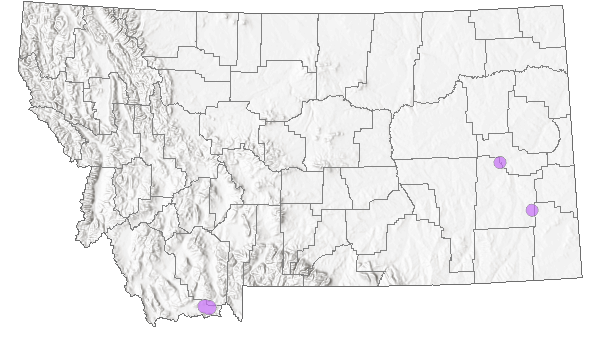
 Native
Native
Range Comments
Variety apus is endemic to Beaverhead County and adjacent southeast Idaho (Lesica et al. 2012). It is a regional endemic.
Variety filifolius grows in the counties of eastern Montana, adjacent North and South Dakota, and other regions of the Great Plains (Barneby 1964). It is rare in the Great Plains except in the sandhill region of Nebraska where it is common (McGregor 1986, Flora of the Great Plains).
Observations in Montana Natural Heritage Program Database
Number of Observations: 4
(Click on the following maps and charts to see full sized version)
Map Help and Descriptions
Relative Density
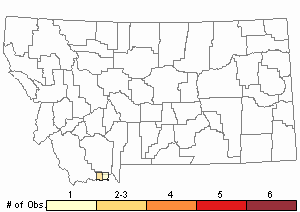
Recency
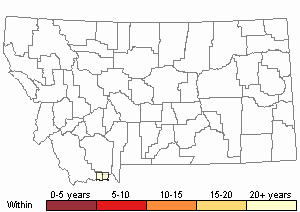

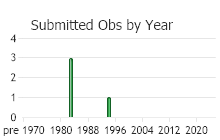
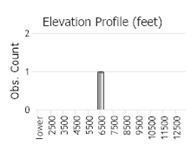 (Observations spanning multiple months or years are excluded from time charts)
(Observations spanning multiple months or years are excluded from time charts)
Habitat
Long distances between occurrences is thought to reduce opportunities for pollen exchange and has led to the perpetuation of small regional differences that consist of many minor races (Barneby 1964). Three varieties have been recognized since at least 1964: ceramicus, apus, and filifolius of which the latter two occur in Montana and are depicted in their own Plant Field Guide accounts.
The species is associated with early successional habitats in sandhills (Schassberger 1988). It is found in sandy, well-drained blowout areas and sandy flats or draws of old sand dunes at elevations of 6650-6700 feet, on moderately steep (20-30%), south- and west-facing slopes. Much of the vegetative cover consists of Artemisia tripartita, Phacelia hastata, Agropyron dasystachyum, Stipa comata and Tetradymia canescens.
Ecological Systems Associated with this Species
Ecology
Painted milkvetch occurs in the sand dune region of the Centennial Valley where there is light to moderate grazing pressure (Culver 1993). It requires the open sand of early successional areas, and suitable habitat may be reduced when plant succession leads to later stages in which vegetation covers areas of formerly open sand (Lesica and Cooper 1998). Historically, the diversity of sandhills plant communities was maintained by a fire cycle of 20-30 years. The activity of pocket gophers (
Thomomys talpoides) also appears to be an important force in initiating blowouts and maintaining early seral vegetation (Lesica and Cooper 1998).
In 1987, the populations in the Centennial Sandhills were reported to be thriving; however in 1993, Culver observed only a few small populations, suggesting that the number of above-ground stems may vary from year to year. A follow-up to this observation is greatly needed.
POLLINATORS The following animal species have been reported as pollinators of this plant species or its genus where their geographic ranges overlap:
Bombus vagans,
Bombus appositus,
Bombus auricomus,
Bombus bifarius,
Bombus borealis,
Bombus centralis,
Bombus fervidus,
Bombus flavifrons,
Bombus huntii,
Bombus mixtus,
Bombus nevadensis,
Bombus rufocinctus,
Bombus ternarius,
Bombus terricola,
Bombus occidentalis,
Bombus pensylvanicus,
Bombus griseocollis, and
Bombus insularis (Macior 1974, Thorp et al. 1983, Mayer et al. 2000, Colla and Dumesh 2010, Wilson et al. 2010, Koch et al. 2012, Miller-Struttmann and Galen 2014, Williams et al. 2014).
Management
The removal of natural disturbance regimes, including fire, ungulate grazing and pocket gopher activity, leads to dune stabilization and reduces the extent of early seral blowout vegetation areas upon which this species depends. Painted milkvetch would benefit from restoration of the fire regime and moderate grazing, at least in years following burns. Severe destabilization of the dunes, e.g., from off-road vehicle use, could also threaten its habitat.
Stewardship Responsibility
Threats or Limiting Factors
Studies have shown that Pottery Milkvetch occurs in early successional habitats that are maintained by grazing or fire. Threats would include any process or action that hinders or prevents grazing or fire; however, the scope, severity, or timing of such threats have not been documented (MTNHP Threat Assessment 2021).
Plants occur in habitats where the potential for off-highway vehicle use is real; however, actual use has not been documented at any known occurrence.
Invasive plants are a potential threat to its habitat though current assessments on the condition of occupied habitats have not been made.
STATE THREAT SCORE REASON
A reported threat to Montana’s populations of Painted Milkvetch includes natural ecological succession of the habitat (MTNHP Threat Assessment 2021). Plants require early successional habitat, which can be maintained by grazing and/or fire. Potential threats to populations could also come from incompatible recreational activities and invasion by non-native plant species is greatly needed (MTNHP Threat Assessment 2021).
References
- Literature Cited AboveLegend:
 View Online Publication
View Online Publication Barneby, R.C. 1964. Atlas of North American Astragalus. 2 Vols. New York Botanical Garden, Bronx, New York. 1188 pp.
Barneby, R.C. 1964. Atlas of North American Astragalus. 2 Vols. New York Botanical Garden, Bronx, New York. 1188 pp. Colla, S.R. and S. Dumesh. 2010. The bumble bees of southern Ontario: notes on natural history and distribution. Journal of the Entomological Society of Ontario 141:39-68.
Colla, S.R. and S. Dumesh. 2010. The bumble bees of southern Ontario: notes on natural history and distribution. Journal of the Entomological Society of Ontario 141:39-68. Koch, J., J. Strange, and P. Williams. 2012. Bumble bees of the western United States. Washington, DC: USDA Forest Service, Pollinator Partnership. 143 p.
Koch, J., J. Strange, and P. Williams. 2012. Bumble bees of the western United States. Washington, DC: USDA Forest Service, Pollinator Partnership. 143 p. Lesica, P., M.T. Lavin, and P.F. Stickney. 2012. Manual of Montana Vascular Plants. Fort Worth, TX: BRIT Press. viii + 771 p.
Lesica, P., M.T. Lavin, and P.F. Stickney. 2012. Manual of Montana Vascular Plants. Fort Worth, TX: BRIT Press. viii + 771 p. Macior, L.M. 1974. Pollination ecology of the Front Range of the Colorado Rocky Mountains. Melanderia 15: 1-59.
Macior, L.M. 1974. Pollination ecology of the Front Range of the Colorado Rocky Mountains. Melanderia 15: 1-59. Mayer, D.F., E.R. Miliczky, B.F. Finnigan, and C.A. Johnson. 2000. The bee fauna (Hymenoptera: Apoidea) of southeastern Washington. Journal of the Entomological Society of British Columbia 97: 25-31.
Mayer, D.F., E.R. Miliczky, B.F. Finnigan, and C.A. Johnson. 2000. The bee fauna (Hymenoptera: Apoidea) of southeastern Washington. Journal of the Entomological Society of British Columbia 97: 25-31. McGregor, R.L. (coordinator), T.M. Barkley, R.E. Brooks, and E.K. Schofield (eds). 1986. Flora of the Great Plains: Great Plains Flora Association. Lawrence, KS: Univ. Press Kansas. 1392 pp.
McGregor, R.L. (coordinator), T.M. Barkley, R.E. Brooks, and E.K. Schofield (eds). 1986. Flora of the Great Plains: Great Plains Flora Association. Lawrence, KS: Univ. Press Kansas. 1392 pp. Miller-Struttmann, N.E. and C. Galen. 2014. High-altitude multi-taskers: bumble bee food plant use broadens along an altitudinal productivity gradient. Oecologia 176:1033-1045.
Miller-Struttmann, N.E. and C. Galen. 2014. High-altitude multi-taskers: bumble bee food plant use broadens along an altitudinal productivity gradient. Oecologia 176:1033-1045. MTNHP Threat Assessment. 2021. State Threat Score Assignment and Assessment of Reported Threats from 2006 to 2021 for State-listed Vascular Plants. Botany Program, Montana Natural Heritage Program, Helena, Montana.
MTNHP Threat Assessment. 2021. State Threat Score Assignment and Assessment of Reported Threats from 2006 to 2021 for State-listed Vascular Plants. Botany Program, Montana Natural Heritage Program, Helena, Montana. Thorp, R.W., D.S. Horning, and L.L. Dunning. 1983. Bumble bees and cuckoo bumble bees of California (Hymenoptera: Apidae). Bulletin of the California Insect Survey 23:1-79.
Thorp, R.W., D.S. Horning, and L.L. Dunning. 1983. Bumble bees and cuckoo bumble bees of California (Hymenoptera: Apidae). Bulletin of the California Insect Survey 23:1-79. Williams, P., R. Thorp, L. Richardson, and S. Colla. 2014. Bumble Bees of North America. Princeton, NJ: Princeton University Press. 208 p.
Williams, P., R. Thorp, L. Richardson, and S. Colla. 2014. Bumble Bees of North America. Princeton, NJ: Princeton University Press. 208 p. Wilson, J.S., L.E. Wilson, L.D. Loftis, and T. Griswold. 2010. The montane bee fauna of north central Washington, USA, with floral associations. Western North American Naturalist 70(2): 198-207.
Wilson, J.S., L.E. Wilson, L.D. Loftis, and T. Griswold. 2010. The montane bee fauna of north central Washington, USA, with floral associations. Western North American Naturalist 70(2): 198-207.
- Additional ReferencesLegend:
 View Online Publication
View Online Publication
Do you know of a citation we're missing? Culver, D.R. 1993. Sensitive plant species inventory in the Centennial Valley, Beaverhead County, Montana. Unpublished report to the Butte District, Bureau of Land Management. Montana Natural Heritage Program, Helena, 42 pp. plus appendices.
Culver, D.R. 1993. Sensitive plant species inventory in the Centennial Valley, Beaverhead County, Montana. Unpublished report to the Butte District, Bureau of Land Management. Montana Natural Heritage Program, Helena, 42 pp. plus appendices. Culver, D.R. 1994. Floristic analysis of the Centennial Region, Montana. M.Sc. Thesis. Montana State University, Bozeman. 199 pp.
Culver, D.R. 1994. Floristic analysis of the Centennial Region, Montana. M.Sc. Thesis. Montana State University, Bozeman. 199 pp. Lesica, P. & S. V. Cooper. 1998. Succession and disturbance in sandhills vegetation: constructing models for managing biological diversity. Conservation Biology 13:293-302.
Lesica, P. & S. V. Cooper. 1998. Succession and disturbance in sandhills vegetation: constructing models for managing biological diversity. Conservation Biology 13:293-302. Lesica, P., M.T. Lavin, and P.F. Stickney. 2022. Manual of Montana Vascular Plants, Second Edition. Fort Worth, TX: BRIT Press. viii + 779 p.
Lesica, P., M.T. Lavin, and P.F. Stickney. 2022. Manual of Montana Vascular Plants, Second Edition. Fort Worth, TX: BRIT Press. viii + 779 p. Schassberger, L.A. 1987. The ecology of Astragalus ceramicus var. APUS in relation to succession in the Centennial Sandhills of southwestern Montana. [Progress report to The Nature Conservancy].
Schassberger, L.A. 1987. The ecology of Astragalus ceramicus var. APUS in relation to succession in the Centennial Sandhills of southwestern Montana. [Progress report to The Nature Conservancy]. Schassberger, L.A. 1988. Effects of grazing on the habitat of Astragalus ceramicus var. Apus in the sandhills of the Centennial Valley, Montana. M.A. thesis. University of Montana, Missoula, Montana.
Schassberger, L.A. 1988. Effects of grazing on the habitat of Astragalus ceramicus var. Apus in the sandhills of the Centennial Valley, Montana. M.A. thesis. University of Montana, Missoula, Montana.
- Web Search Engines for Articles on "Painted Milkvetch"





